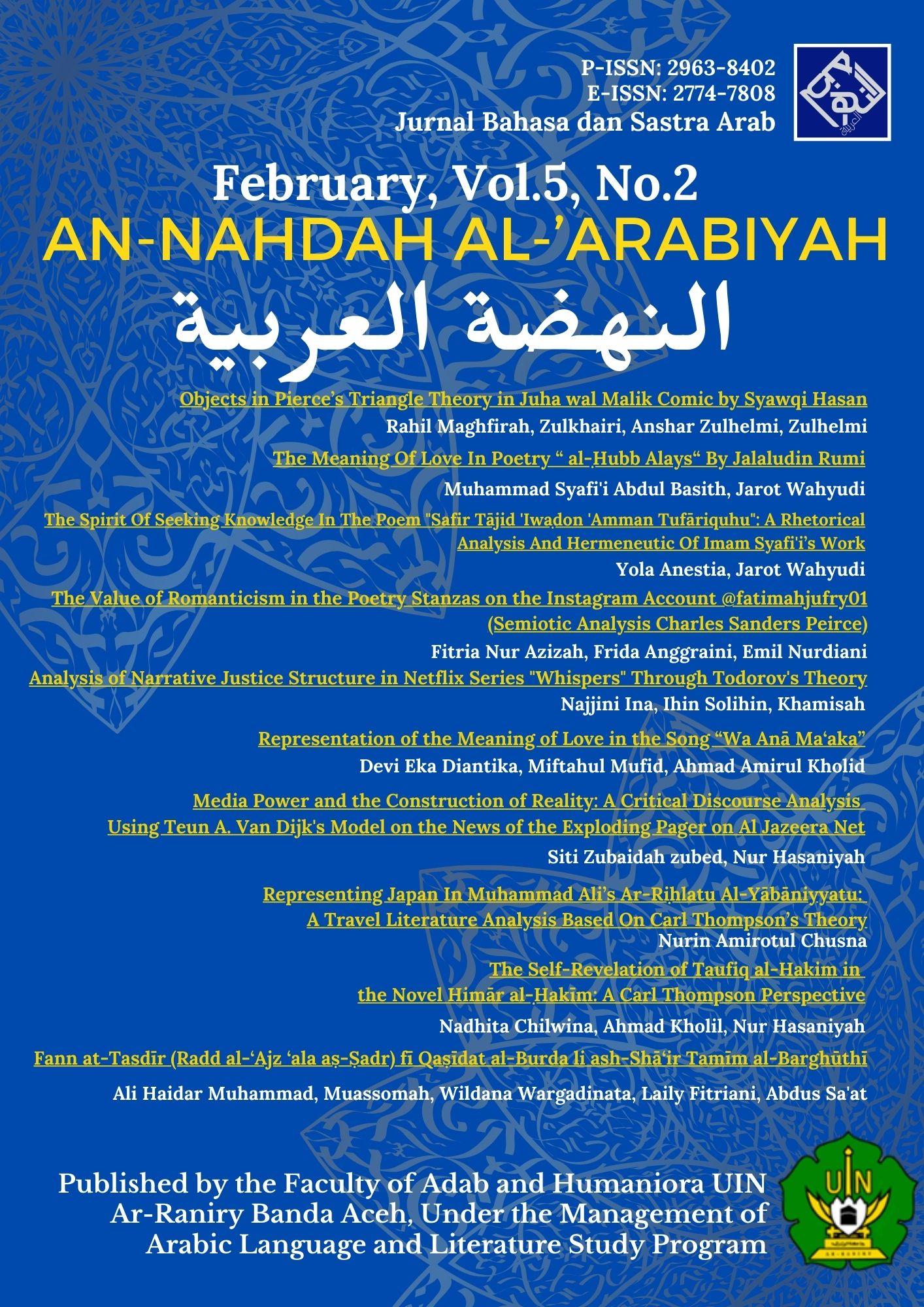Representing Japan In Muhammad Ali’s Ar-Riḥlatu Al-Yābāniyyatu: A Travel Literature Analysis Based On Carl Thompson’s Theory
Tamthīlu al-Yābān fī Riḥlat Muḥammad ʿAlī: ar-Riḥlah al-Yābāniyyah – Dirāsah fī Adab ar-Riḥlah ʿalā ḍawʾ Naẓariyyat Kārl Ṭūmpsūn
DOI:
https://doi.org/10.22373/nahdah.v5i2.7699Keywords:
sastra perjalanan, Carl Thompson, Travel Literature, Muhammad Ali, Japan, كارل تومسون, الأدب الرحلة, محمد على, اليابان, JepangAbstract
This study discusses the depiction of the Japanese world in Muhammad Ali's ar-Riḥlatu al-Yābāniyyatu by utilizing Carl Thompson's theory of travel literature. The purpose of this study is to reveal how Japan is depicted from an Arab perspective. This research uses a descriptive qualitative method with text analysis techniques on quotations that describe Japanese cities. The results show that Muhammad Ali's depiction of Japan is not only informative and descriptive, but also full of personal judgments that reflect his cultural background, aesthetics, and identity as an Arab writer. Thus, the novel serves as cultural mediation, demonstrating the dual perspective of admiration and critique through Arab subjectivity.
تتناول هذه الدراسة تصوير العالم الياباني في رواية الرحلة اليابانية لمحمد علي، من خلال توظيف نظرية أدب الرحلة لكارل تومسون. وتهدف الدراسة إلى الكشف عن كيفية تصوير اليابان من منظور عربي. وقد استخدمت الدراسة المنهج الوصفي التحليلي بأسلوب تحليل النصوص المقتبسة التي تصف المدن اليابانية. وأظهرت نتائج الدراسة أن تصوير محمد علي لليابان لم يكن مجرد تصوير معلوماتي ووصفي، بل كان مليئًا بالتقييمات الشخصية التي تعكس الخلفية الثقافية والجمالية والهوية الذاتية له ككاتب عربي. وبالتالي، فإن هذه الرواية تُعد شكلًا من أشكال الوساطة الثقافية التي تُظهر كيف يتم فهم العالم الأجنبي وانتقاده وتصورّه من قبل الرحّالة.
Penelitian ini membahas penggambaran dunia Jepang dalam novel ar-Riḥlatu al-Yābāniyyatu karya Muhammad Ali dengan memanfaatkan teori sastra perjalanan Carl Thompson. Tujuan penelitian ini adalah untuk mengungkap bagaimana Jepang digambarkan dari sudut pandang orang Arab. Penelitian ini menggunakan metode deskriptif kualitatif dengan teknik analisis teks terhadap kutipan-kutipan yang menggambarkan kota-kota di Jepang. Hasil penelitian menunjukkan bahwa penggambaran Muhammad Ali terhadap Jepang tidak hanya bersifat informatif dan deskriptif, tetapi juga sarat akan penilaian personal yang mencerminkan latar belakang budaya, estetika, dan identitasnya sebagai penulis Arab. Dengan demikian, novel ini menjadi bentuk mediasi budaya yang memperlihatkan bagaimana dunia asing dipahami, dikritisi, dan dipersepsikan oleh pelancong.
References
Alwi, Hasbiallah. (2023). The Depiction of Indonesia in 1954 in the Travelogue Șuwarun Mi al-Sẖarq; Fī Indūnīsiyā by Ali Al-Țanțāwī: Carl Thompson's Travel Literature Analysis. MECRI Journal, Vol 2(2), 176–192.
Ali, Muhammad. (1910). Ar-Riḥlatu Al-Yabaniyyatu. Cairo: Hindawi.
Hidayah, Ahmad Taqiyuddin, Abdullah & Atikurrahman. (2022). Anasir-Anasir of Travel Story in Helen and Sukanta: Carl Thompson's Travel Writing. Suluk Journal, Vol 4(1), 47–56.
Husain, Husni Mahmud. (1983). Adabu ar-Riḥlati 'Inda al-'Arabi. Beirut: Dār al-Andalusi.
Sholeh Bin Ali Al-Hamid. Ilatu. Thesis. Master of Middle Eastern Cultural Studies, Faculty of Cultural Sciences, Gadjah Mada University. Unpublished.
Insani, Hermawati Putri D. (2022). The Journey of Arab Literature in Indonesia in the Novel Rihlatu Jawa Al-Jam.
Mashlihatin, Anis. (2015). Depiction of the World in the Travel Novel 99 Cahaya di Langit Eropa. Journal of Poetics, Vol III(1), 3–21.
Mashlihatin, Anis. (2015). The Novel 99 Cahaya di Langit Eropa as a Postcolonial Travel Story. Thesis. Master of Literature, Faculty of Humanities, Gadjah Mada University. Unpublished.
Maulidia, Siti Nur Suci & Zawawi, Moh Z. (2023). Travel Writing of Carl Thompson in Jaulah Fi Rubu’i Asia by Muhammad Tsabit. Lisanudhad: Jurnal Bahasa, Pembelajaran dan Sastra Arab, 10(2).
Thompson, Carl. (2011). Travel Writing: The New Critical Idiom. New York: Routledge.
Yazici, Y. (2024). Meiji Restoration and Modernization: The Role of Intellectuals in The Context of Gramsci’s Theory of Hegemony and Counter-Hegemony. European Scientific Journal, 20(37).















